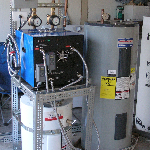 Doron Bracha May 8, 2014 04:14 |
Very interesting idea, seems to have great potential.
I wonder why the focus is on extracting energy from the cold water. There is probably more waste energy in the waste water from the showers and laundry washers.
Also, in cooler climates (like in the North-East for example), the tap water is pretty cold already.
Highly efficient HVAC systems include heat recovery wheels, that extract heat from the exhaust air and use it to warm up the intake air. Perhaps if you could develop a similar system to extract energy from domestic waste water, it would be viable in colder climates as well.
Cheers !..
|
 Tom Morris May 13, 2014 09:40 |
This gave me a rather "out there" idea. Millions of gallons of water goes down drains every day. Could "micro turbines" be used to generate power from the water as gravity makes it flow through the drain. the pwer could be stored in loacl batteries for use in the building where generated.
|
 Tom Morris May 13, 2014 09:59 |
The same method i mentioned above might be used to generate electricity both from the waterflow while showering and the drainage of water. the question would be if the amount of power generated was sufficient to justify the process.
|
 Gunes Hellweger May 29, 2014 08:57 |
Dear Hal,
The heat pumps are definitely a good alternate for reducing the carbon emission. I also appreciate the
fact that you provided an estimate for carbon reduction. However it seems as the estimate is only for replacing the
systems. Did you factor the embodied energy and the energy for manufacturing the heat pumps?
Other than that, I agree with the energy efficiency idea of water-to-water than air-to-water, and also
believe that having hot/cold water tanks will create a thermal energy storage and will benefit the system more.
Best regards,
Gunesh
|
 Dan Whittet Jun 17, 2014 04:10 |
I think waste heat reclamation from drain lines is very much a current reality, although a kind of long payback item in it's current form. To Gunesh's point, we sometimes neglect to factor in the embodied energy of systems (especially solar panels, side point)
As we evaluate new process maybe we should develop simple LCA or EPD metrics.
I see all waste heat and heat pump systems as a form of conservation...and in that sense micro turbines that capture energy from any flow make great sense, if costs are manageable.
|
 Saravanan Dhalavoi Pandian Jun 23, 2014 03:45 |
Hi,
Thank you for the interesting concept!! Could you add more clarity to your concept on the following:
1. The project is named "Geothermal Water Heater (GWHP)" - Could you explain how / where the geothermal energy will be utilized...for water heating?c.
2. Heat pump would require a compressor which would need electricity or any high grade energy to move heat from cold water to hot water. From where the electricity would be sourced? PV based?
3. What would be the cost of the pilot project vs. the savings achieved by replacing the electricity heater with GWHP
4. What would be net electricity / energy (if fuel gas) savings per unit (after deducting energy used for Heat pump compressor) and the approximate CO2 saved per unit
5. Is this system more economical than typical solar water heaters which would be more simpler and proven technology?
All the best,
Saravanan.
|
 Hal Slater Jun 24, 2014 03:14 | Proposal contributor
Saravanan,
Before addressing your comments, I will answer the questions about heat recovery. There are quite a few mature system designs used to recapture heat from drain waste. In very cold climates, it seems to work but has generally not caught on due to the low delta-T for the heat exchange v. the high cost of copper components.
Now your questions
1. I call it geothermal because the heat extracted comes from the ground in which the supply lines are buried though an argument could be made that this is solar energy.
2. Any electric source will do, with an EF of 4.0 it only uses 25% of the energy of a standard electric water heater, though PV is best.
3. I am not sure what you mean by pilot project. The system prototypes were tested in a lab at UC San Diego and in homes in various climate zones. The unit should cost about the same as any heat pump water heater.
4. As noted, the EF of 4.0 represents a 75% savings over conventional electric water heating. Powered by 100% coal (worst case scenario) a family of four creates 4400 lbs of CO2 per year heating water. That would be 3,300 lbs of CO2 per year per unit saved.
5. Solar water heating is actually more complex and problematic (see http://www.halslater.com/Solar-Hot-Water.htm ) and costs about three times as much for a comparable system with a 75% solar fraction.
Thank you all for your comments and questions. Keep them coming.
|
 Climate Colab Aug 6, 2014 12:28 |
This approach does not appear to offer any energy benefit relative to a conventional heat-pump water heater in its target market, i.e., warmer climates - why is the added complexity of integration with water worth it?
|
